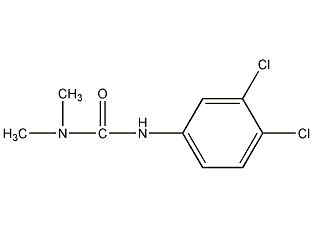
Structural formula
| Business number | 048V |
|---|---|
| Molecular formula | C9H10Cl2N2O |
| Molecular weight | 232 |
| label |
Da Youlong, Dicaojing, Duran, Marmer, Diurex, herbicide |
Numbering system
CAS number:330-54-1
MDL number:MFCD00018136
EINECS number:206-354-4
RTECS number:YS8925000
BRN number:2215168
PubChem ID:None
Physical property data
1. Physical property data
Characteristics: Pure product is white odorless crystal.
Density (g/mL, 25/4℃): 1.48
Relative vapor density (g/mL, air=1): 8.04
Melting point (ºC): 158~159
Boiling point (ºC, normal pressure): 180~190
Boiling point (ºC, 5.2kPa): Not available
Refractive index: Not available
Flash point (ºC): Not available
Ratio Optical rotation (º): Not available
Autoignition point or ignition temperature (ºC): Not available
Vapor pressure (kPa, 25ºC ): 4.13×10-4
Saturated vapor pressure (kPa, 60ºC): Not available
Combustion Heat (KJ/mol): Not available
Critical temperature (ºC): Not available
Critical pressure (KPa): Not available
Log value of oil-water (octanol/water) partition coefficient: not available
Explosion upper limit (%, V/V): not available
Lower explosion limit (%, V/V): Not available
Solubility: slightly soluble in water
Toxicological data
2. Toxicological data:
Acute toxicity: LD50: 1017 mg/kg (rat oral); >5000 mg/kg (rat transdermal). The no-effect dose for dogs is 125mg/kg
Ecological data
1. Other harmful effects: This substance is harmful to the environment, and special attention should be paid to the pollution of water bodies.
Molecular structure data
1. Molar refractive index: 58.66
2. Molar volume (cm3/mol): 170.1
3. Isotonic specific volume (90.2K ): 448.2
4. Surface tension (dyne/cm): 48.1
5. Polarizability (10-24cm3): 23.25
Compute chemical data
1. Reference value for hydrophobic parameter calculation (XlogP): None
2. Number of hydrogen bond donors: 1
3. Number of hydrogen bond acceptors: 1
4. Number of rotatable chemical bonds: 1
5. Number of tautomers:2
6. Topological molecule polar surface area 32.3
7. Number of heavy atoms: 14
8. Surface charge: 0
9. Complexity: 211
10. Number of isotope atoms: 0
11. Number of determined atomic stereocenters: 0
12. Uncertain atoms Number of stereocenters: 0
13. Determine the number of stereocenters of chemical bonds: 0
14. Uncertain number of stereocenters of chemical bonds: 0
15. Number of covalent bond units: 1
Properties and stability
It is irritating to eyes and mucous membranes at high concentrations.
Storage method
None
Synthesis method
1. Synthesized from 3,4-dichloroaniline, phosgene and dimethylamine.
2.After p-chloronitrobenzene is mixed with an appropriate amount of catalyst anhydrous FeCl3, chlorine gas is passed through it at a certain temperature to perform a chlorination reaction to produce 3, 4-Dichloronitrobenzene. The nitro compound is reduced to obtain 3,4-dichloroaniline. The obtained 3,4-dichloroaniline was added dropwise to the toluene solution saturated with phosgene, and the reaction yielded 3,4-dichlorophenyl isocyanate. Finally, 3,4-dichlorophenyl isocyanate reacts with dimethylamine to obtain diuron.
3.Chlorination: Combine a certain amount of melted and dehydrated p-chloronitrobenzene with an appropriate amount of catalyst anhydrous After the mixture of C4 and C3 is mixed, the temperature is raised to 100-105°C, chlorine is introduced, the chlorination temperature is 100-110°C, and the reaction is carried out for 8-9 hours to obtain 3,4-dichloronitrobenzene.
4.Reduction Reduce the above nitro compound to prepare3 ,4-dichloronitrobenzene.
At present, there is still production in China using the method of reducing iron powder and water in the electrolyte. Operation process: Mix measured water, iron powder, a small amount of hydrochloric acid, electrolyte ammonium chloride and copper sulfate, raise the temperature to 95~100℃, then add 2,4 dropwise -Dichloronitrobenzene, and keep it in the reflux state (105~110℃) for 3 hours, filter and dehydrate to obtain 3,4-dichloroaniline.
5.Esterification: Saturate the toluene solution with phosgene at 0°C, then add 3,4- For dichloroaniline, control 0 to 10°C and complete the addition in about 15 minutes. Then continue to introduce phosgene, slowly increase the reaction temperature to 40°C, increase the phosgene flow rate, then raise the temperature to 65 to 75°C, react for 1 to 2 hours, and the material After it becomes clear, stop passing phosgene, quickly raise the temperature to 90-100°C, pass nitrogen or dry air to drive away excess phosgene and hydrochloric acid gas, and obtain 3,4-dichlorophenyl isocyanate.
6.Add 3,4-dichlorophenyl isocyanate and mix with the solvent toluene, cool to below 20℃, Add 40% dimethylamine aqueous solution (ester-to-amine ratio is 1:1.05), the temperature will rise to 34°C on its own, and be controlled not to exceed 50°C. React for 2 hours, with a pH value of 7 to 8, then centrifuge and filter, recover the solvent, and wash the filter cake. After becoming neutral, it is dried at 90-100℃ to prepare diuron.
Purpose
1. This product is a herbicide, used to control common weeds in non-cultivated land, and also used for selective weeding in cotton fields.
2.Replaces urea herbicides and has systemic conduction and certain contact effects. After being absorbed by plant roots or leaves, photosynthesis is inhibited, causing leaves to become chlorotic and leaf tips and edges to fade. Diuron can be used for weeding at low doses through position difference and time difference selection. Becomes a biocidal herbicide at high doses. It is mainly used to control annual grass weeds in crops such as cotton, soybeans, tomatoes, tobacco, strawberries, grapes, orchards, and rubber plantations. Such as dry barnyard grass, crabgrass, foxtail grass, wild amaranth, sedge, etc.



